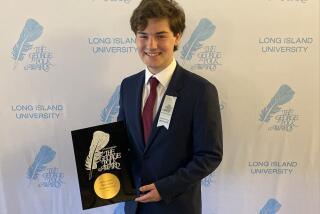Stanford Ovshinsky dies at 89; inventor founded new field of electronics
Stanford Ovshinsky was not a household name like Thomas Edison or Albert Einstein, but he was often compared to them, for good reason.
He invented the nickel-metal hydride battery, which has powered high-tech items such as cellphones, laptop computers and hybrid cars.
He created paper-thin solar panels potent enough to work on a cloudy day and cheap enough to be produced in sheets a mile long.
PHOTOS: Notable deaths of 2012
He founded a whole field of electronics that earned him a mention in dictionaries (see “ovonics”) and led to such marvels of modern life as the flat-screen TV.
Ovshinsky, who never went to college yet transformed the alternative energy, information and automotive industries with his inventions, died of prostate cancer Wednesday at his home in Bloomfield Hills, Mich., according to his son Harvey. He was 89.
The self-taught scientist-inventor pursued audacious ideas throughout his long career, often attracting the scorn of other scientists who said his schemes were foolish, impractical or just plain impossible.
In some respects, they were right. He ran Energy Conversion Devices, a product development company, for 40 years, few of which were profitable. Although it drew blue-chip investors such as General Motors, 3M and Intel, it performed so poorly from a business standpoint that Forbes magazine once described it as “a high-tech Roach Motel” where “the money goes in but it never comes out.”
But Ovshinsky’s path-breaking discoveries led his admirers to associate him with other brilliant minds such as Edison, the inventor from an earlier era who founded General Electric.
“It’s difficult to compare one genius with another genius,” said University of Chicago physicist Hellmut Fritzsche, who consulted for Ovshinsky and later became a vice president of Energy Conversion Devices, “but I’ve known great people, having been at the University of Chicago for over 40 years, and I consider Stan Ovshinsky the only genius I ever met. ... Everything he touches is new, different, wonderful.”
Ovshinsky made a scientific name for himself in 1968, when he went public with research showing that glass could be engineered to conduct electricity. He predicted that glass semiconductors would one day replace crystalline transistors.
To argue, as he did, that cheap noncrystalline materials such as glass could perform as well as more expensive silicon crystals sounded preposterous and was derided by readers of Physical Review Letters, the prestigious American physics journal that published Ovshinsky’s findings.
But his paper eventually became one of the five most cited publications in the journal’s history, and his prediction became prophecy, spawning a new field he called ovonics.
Born in Akron, Ohio, on Nov. 24, 1922, he was the son of Bertha Munitz and Benjamin Ovshinsky, a Lithuanian immigrant and Eugene Debs socialist who acted in Yiddish theater before entering the scrap business. Young Stan fell in love with machinery while accompanying his father to foundries and machine shops.
A mediocre student, he spent hours in the Akron public library, where his real education took place.
“His teachers didn’t understand him, but his librarian did,” his son said Friday. “The librarian let him take out adult books without questioning or challenging him. He was tireless in his curiosity.”
Ovshinsky’s formal education ended when he graduated from high school in 1941. Exempted from military service during World War II because of his asthma, he worked as a toolmaker and married Norma Rifkin, a childhood sweetheart.
That marriage ended in divorce. In 1959 he married Iris L. Miroy; she died in 2006. He later married Rosa Young, who survives him along with three sons from his first marriage, four stepchildren, a brother and six grandchildren and step-grandchildren.
Ovshinsky had his first success as an inventor in 1947 when he developed a high-speed automatic lathe. In 1952 he left Akron for Detroit to direct research and development for the Hupp Corp., an automotive and defense supplier. During the day he helped devise automatic tracking systems for tanks. At night he studied the human brain, which helped him form the ideas behind his groundbreaking work on semiconductors.
In 1960 he and his second wife, Iris, founded what became Energy Conversion Devices with the goal of using science and technology to solve the world’s environmental and social problems. Its nickel-metal hydride battery, often called the NiMH, was one of its most successful products, used in consumer electronics as well as electric and hybrid vehicles like the Toyota Prius and Honda Insight.
The company also provided the batteries for General Motors’ short-lived EV1 electric car. Ovshinsky’s commitment to alternative energy sources earned him a spot on Time magazine’s list of “Heroes for the Planet” in 1999.
He retired from Energy Conversion Devices in 2007. The company filed for bankruptcy this year and a liquidation plan was approved in August.
But Ovshinsky, who held more than 300 patents, did not stop inventing. He was writing patents and starting new companies well into his 80s, focusing his last years on advancing his goal of making electricity from sunlight cheaper than making it from coal.
“A real inventor,” he told the Detroit Free Press in 2008, “is not motivated by money. It’s about the idea and the creation.”
More to Read
Start your day right
Sign up for Essential California for the L.A. Times biggest news, features and recommendations in your inbox six days a week.
You may occasionally receive promotional content from the Los Angeles Times.






